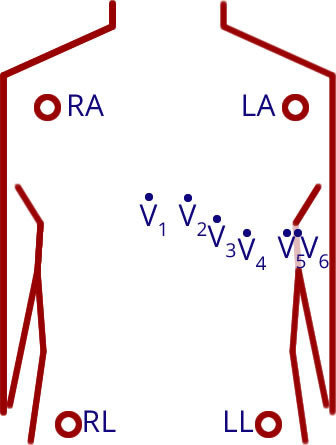Heart rate data
Which Heart Rate data signals are available in NoldusHub?
The availability of different Heart Rate data signals depends on your version of NoldusHub:
Two methods to measure heart rate data
NoldusHub measures heart rate data based on two methods that give similar results, but have important differences which will be discussed on this page. The two methods are:
- Photoplethysmography (PPG)
- Electrocardiography (ECG)
ECG
ECG determines the heart rate by measuring the electrical signals coming from the heart. It is a reference signal for health assessment and for research. For measurement, several electrodes are placed on the chest. Each electrode has its own signal which can be found in NoldusHub under the names lead I, lead II, lead III.
PPG
PPG determines heart rate by measuring changes in light reflection or transmission through the skin due to blood volume changes. It is generally measured with a single sensor on a finger or an ear lobe.
Raw and derived signals
The picture below is an example of a raw ECG signal and a raw PPG signal. Due to the fact that blood must travel through the body, the peaks in the PPG signal are later than the peaks in the ECG signal.
Heart rate is the number of peaks per minute.
Interbeat interval (IBI) is the number of ms between two heart beats.

Differences between ECG and PPG data
ECG |
PPG |
|
Direct – electrical current from the heart |
Indirect – reflection by blood volume |
|
Reference signal for health |
Uses ECG as ground truth and research |
|
Invasive - several sensors on chest |
Non invasive - one sensor on ear lobe or finger |
|
Accurate |
Sensitive to noise and movement |
|
Sharp peak, accurate pulse detection |
Broad peak, pulse detection is less accurate |
|
Data obtained accurately using a small time window and real-time signal |
Requires time window of several minutes for accurate data |
Signals present in NoldusHub
PPG
- Heart rate (BPM): the number of peaks, heart Beats, Per Minute.
- Interbeat interval (ms): the number of ms between two heart beats.
- Raw data: the raw PPG signal.
ECG
- Heart rate (BPM): the number of peaks, heart Beats, Per Minute.
- Interbeat interval (ms): the number of ms between two heart beats.
- Lead 1 (mV): the ECG vector signal measured from RA to LA.
-
Lead 2 (mV): the ECG vector signal measured from the RA to LL.
-
Lead 3 (mV): the ECG vector signal measured from the LA to LL. This is derived by subtracting Lead 1 from Lead 2.
- Vx (mV): The ECG vector signal measured from the average of the RA, LA and LL to the V electrode.
For more details on the Lead and Vx signals, consult the Shimmer ECG user guide.
Data processing
The heart rate data are preprocessed in the following way:
- High pass filter - The data below 0.5 HZ is not included.
- Notch filter - To remove artifacts caused by the power frequency, the 50 (Europe) or 60 (USA) Hz frequency band is not included.

No Comments